How To Grow A Lemon Tree From A Cutting
Lemon trees (Citrus x limon) add beauty to yards and patios. As perennials in U.S. Department of Agriculture plant hardiness zones 9 through 11, they also supply tart, yellow fruit. You can grow a lemon tree from a cutting, although the resulting tree may lack the same disease resistance and resilience found in commercially grown lemon trees, which are usually grafted. Growing a lemon tree from a cutting is simple, but you need to make sure you're using sterile tools and giving the cutting the conditions it needs to grow into a healthy, productive tree.
Follow these step-by-step instructions to grow a lemon tree from a cutting.
1. Prepare the Lemon Tree Container
Before taking a cutting, prepare a container so the cutting can be potted immediately. Any container will do as long as it has plenty of drainage holes and holds around 1 gallon of soil. Fill it with sterile seed-starting mix, or a homemade mixture of half vermiculite or perlite and half milled peat moss. Don't use garden soil because it may contain disease-causing fungi and bacteria.
Peat-based growing mixtures resist water at first, so keep adding water and stirring the mixture until it holds moisture. An eco-friendly alternative to peat moss is coconut coir, also marketed as coco coir, which wets easily and has a pH level between 6.0 and 6.7. Be sure to use a coco coir product that has been washed to remove the ocean salts accumulated by the coconut tree.
2. Take a Lemon Tree Cutting
Late spring and early summer are the best times to take lemon cuttings. Take a 6-inch cutting from the tip of a healthy young branch, and choose one with:
- No fruit or flowers because both draw energy away from root production.
- At least two to three nodes along the stem. Nodes are where leaves emerge, and they contain the types of cells needed for root production.
- No signs of disease, stress or damage. Yellow or wilted leaves and stunted growth both warn of potential trouble.
Measure back 6 inches from the tip and cut the stem at a 90-degree angle using a sharp, non-serrated knife that has been sanitized by wiping it with isopropyl alcohol. Wrap the cutting in moist paper towel while moving it to your work station.
3. Pot the Cutting
Before potting the lemon tree cutting, remove all but the four leaves at the tip to minimize moisture loss. Remove the bottom two sets of leaves to reveal the nodes. Cut the base of the stem at a 45-degree angle using a sanitized knife, then dust the end and the bottom two nodes with rooting hormone powder.
Make a hole in the moistened growing mixture that is deep enough to hold the bottom two nodes of the lemon cutting. Stick the hormone-dusted portion of the stem inside and firm the mixture against the stem.
Lemon tree cuttings need warmth and high humidity, so cover the pot with a large clear plastic bag. Hold up the bag with chopsticks or wire to keep it from resting against the cutting, and make one or two 1-inch slices in the bag to let excess moisture escape.
4. Root the Lemon Tree Cutting
Lemon tree cuttings need little coddling to root, but meeting their needs will give them the best chance.
- Try to provide constant warmth. Soil temperatures between 70 and 80 degrees Fahrenheit are best for rooting, although temperatures that are too high cause stress-related failure.
- Place the cuttings in a spot that gets bright, diffuse light. Avoid direct sun because it will stress the cutting.
- Keep the growing mixture moist, but let the surface dry out a bit between waterings. Mist the cutting every day to increase humidity.
Rooting times vary, but you can test for roots starting in eight weeks by tugging very gently on the base of the cutting. If it resists the movement, it has rooted. Cut open the bag and let the rooted cutting acclimate to normal humidity before removing the bag entirely.
5. Transplant the Lemon Tree and Provide Aftercare
Transplant the lemon cutting into a 1-gallon nursery container filled with standard potting mix once it shows signs of growth. Set the pot in a bright, sheltered area outdoors with where temperatures stay above 60 degrees Fahrenheit.
Water the cutting when the soil feels dry to the touch, adding water until the excess dribbles from the pot's drainage holes. Lemon trees are not heavy feeders. Water every two weeks with a solution made of 1/2 teaspoon of 10-10-10 fertilizer dissolved in 1 gallon of water, or an organic equivalent.
Grow the lemon tree cutting in its pot for at least one season, then transplant into a permanent pot with drainage holes or into the garden in spring when all chance of frost has passed.
